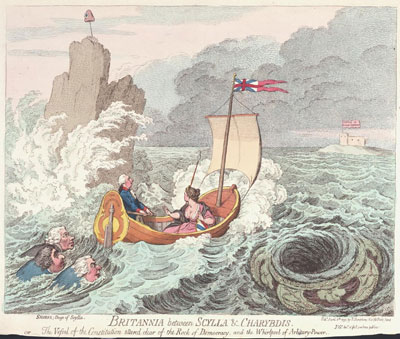Britannia between Scylla and Charybdis
If this print were not conspicuously signed "Js. Gy, desn et fect pro bono publico," and published in 1793, one could be forgiven for thinking that it was one of those pro-Pitt propaganda pieces, designed by George Canning and produced while Gillray was receiving a stipend to support the Tories.
Unlike Gillray's own designs which usually cut in multiple directions, Britannia between Scylla and Charybdis is, satirically, one-dimensional. Prime Minister William Pitt is shown, uncaricatured, deftly steering the ship of state, the Vessel of the Constitution, between "the Rock of Democracy" (Scylla) and "the Whirlpool of Arbitrary Power" (Charybdis) towards the sunny and safe "Haven of Public Happiness"

© Lewis Walpole Library, Yale University
On the other hand, the three prominent Whigs (from top to bottom)—Joseph Priestley, Charles James Fox, and Richard Brinsley Sheridan— trail along jealously behind, and are identified as "Sharks:Dogs of Scylla."
The overall treatment of the print, the incredibly detailed and sophisticated etching, is such as Gillray would have spent on a premier customer, and recalls the time and effort he lavished on his "serious" prints such as The Nancy Packet (1784) and the The Duke of Athol, East Indiaman (1785). Like them, it demonstrates Gillray's mastery of the creation of surging seas, crashing waves, and storm clouds—all the while credibly depicting the Vessel of the Constitution as it rides beautifully balanced amidst the churning waters. It is masterful; and it is unimaginable by any other caricaturist of his time.
It is also masterful in its design. In classical mythology Scylla was a once beautiful woman who had been transformed by Circe into a hideous monster who inhabited a cave half way up the steep cliffs on one side of a narrow strait. She had twelve feet and six heads with shark-like teeth. As Odysseus discovers in Homer's epic, ships passing too near or too slowly by Scylla find their crews snatched up and eaten by her six heads. Her voice is described like the barking of dogs. And, in fact, she is sometimes depicted with snarling dogs emerging from her waist. With consummare skill, Gillray culls details from classical descriptions and images of Scylla to portray a scene that is both realistic and symbolic. He maintains the steep cliff, but uses the spray from the waves crashing against the rocks to suggest Scylla's tentacle-like heads reaching out to grasp Britannia in her vessel. The rows of sharp teeth and dogs are alluded to in the picket fence on top of the cliff beneath the revolutionary bonnet rouge and by the identification of the Whigs as "Sharks: Dogs of Scylla.
But perhaps the most brilliant element of Gillray's design is his rendering of Charybdis. In classical mythology, Charybdis, like Scylla, was a sea monster. She lived under a small rock opposite the larger cliffs of Scylla. Three times a day Charybdis swallowed a huge quantity of water, sucking in, like a whirpool, anything within its reach. Gillray portrays the open mouth of the whirlpool, but beneath it he shows a royal crown ready to absorb all power into itself. The whole design is wonderfully simple in its realization. You can see the clear and present dangers, and the skill in navigating between them. It is not surprising that in most discussions of "Between Scylla and Charybdis," Gillray's print is shown as the best example.
Gillray was typically scrupulous about attribution; if anything he tended to understate his contribution to a print. So if he claims here to have both designed and etched the print, I think we must take him at his word. And we must also remember that Britannia between Scylla and Charybdis was published in 1793. His relationship with George Canning and his stipend from the Tories did not begin for another four and a half years (November of 1797). Indeed it is probably Canning who is indebted to Gillray for Canning's poem to Pitt on his birthday in 1802 called "The Pilot that Weathered the Storm."
Does, then, Britannia between Scylla and Charybdis really represent Gillray's views? In April of 1793, yes. Ever since the publication of Burke's Reflections on the Revolution in France (November 1790), and especially after its predictions of lawlessness and chaos in France began to come true, Gillray had been leaning right. He still had reservations about the power of Pitt and the Crown (see An Excrescence, a Fungus, alias a Toadstool upon a Dunghill (12/20/1791),especially when it came to threatening free speech as in Vices Overlook'd in the New Proclamation(05/24/1792). But in his reaction to Pitt and the Crown, there is nothing like the horror and disgust portrayed by Gillray time and time again in prints featuring Fox and the Whigs like The Hopes of the Party Prior to July 14th (07/19/1791), and A Democrat, or Reason & Philosophy (03/01/1793). Like Britannia who looks in trepidation towards Scylla, Gillray seems to have believed (rightly) that Britain had more to fear from France than from within, and that with the recent execution of the French King on January 21st and the declaration of war against Britain and Holland on February 1st, Pitt was the best pilot going forward.
Sources and Reading
- Commentary from the British Museum on Britannia between Scylla and Charybdis.
- "Scylla," Wikipedia
- "Skylla," Theoia Greek Mythology
- "Charybdis," Wikipedia
- "William Pitt the Younger," Wikipedia
- "Charles James Fox," Wikipedia
- "Richard Brinsley Sheridan," Wikipedia
- "Joseph Priestley," Wikipedia
- "War of the First Coalition," Wikipedia
- Thomas Wright and R.H. Evans, Historical and Descriptive Account of the Caricatures of James Gillray #102.
- Thomas Wright and Joseph Grego, The Works of James Gillray, the Caricaturist; With the History of His Life and Times, p. 168-9.
Comments & Corrections
NOTE: Comments and/or corrections are always appreciated. To make that easier, I have included a form below that you can use. I promise never to share any of the info provided without your express permission.